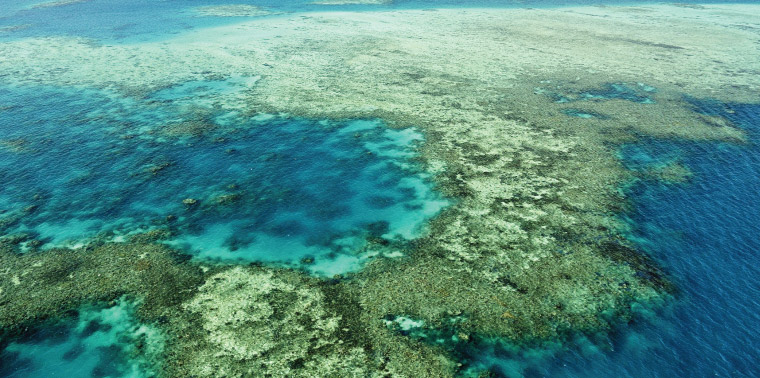January 5, 2014 — Seven billion people and growing. A quarter of them living in poverty. Unsustainable — and unequal — resource use. Landscapes vanishing, along with their nonhuman inhabitants. Global warming upending natural systems. These are tough times on planet Earth. But while sustainability remains far from a global edict, hopeful signs of progress are poking up around the world. In some places, in some cases, we are doing things right, taking steady steps toward a smarter future. Here we offer seven of them — seven concrete answers to seven of the most pressing and vexing environmental dilemmas of the 21st century. None is perfect. But each elegant effort attests to the fact that effective and relatively simple solutions are already within our reach. The main missing ingredient is one that’s seemingly scarce but in fact unlimited, and which we’ll need to gather and harness in order to change course and stay that way: resolve.
1: Great Barrier Reef
Challenge: Ocean fisheries collapse
Opportunity: Marine Protected areas
Across the planet’s oceans, more than 70 percent of fish species are either overharvested or at the very brink of what their populations can tolerate. A groundbreaking 2006 study painted a grim picture: At current rates, every seafood fishery on the planet will collapse by mid-century. We are drastically altering ocean ecosystems — and at the same time threatening the food security of 200 million people.
One solution is proving successful everywhere it’s employed: the no-take reserve, whose biggest story comes from Australia.
The Great Barrier Reef is home to an almost incomprehensible number of species. There are 1,500 types of fish, 400 kinds of coral, 5,000 varieties of mollusk and 500 different species of seaweed. But despite the fact that the area — all 214,000 square miles of it — has been a designated marine park since the 1970s, its biodiversity was under threat until not long ago. The marine park is a multiuse area, with activities ranging from diving to commercial fishing permitted in some parts. In fact, until 2010, fishing was totally banned in less than 5 percent of the park.
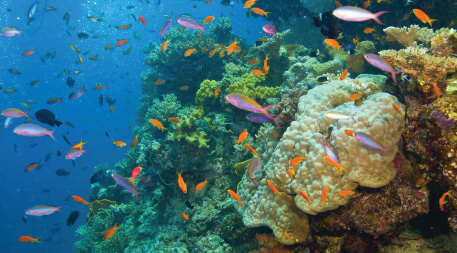
The benefits of no-take reserves range from economic gains due to tourism to more sustainable seafood populations beyond reserve borders. © Debra James / Shutterstock.com.
Recognizing that more needed to be done, the Australian government convened a panel of scientists who recommended expanding the Great Barrier Reef Marine Park’s no-take areas. Today, fishing is banned in one-third of the park. And evidence of success is rolling in. The thriving Great Barrier Reef, with its sightseers, snorkelers, divers and fishers, now generates nearly 54,000 full-time jobs and $5.4 billion per year, with tourism providing roughly 36 times more revenue than commercial fishing. Having fish alive in the water, it turns out, is highly profitable.
What’s more, research published in May 2012 shows that the benefits of no-take areas spill beyond their invisible borders. Using genetic techniques, scientists studied the origins of coral trout and stripey snapper, two species of commercial fish in a 1,000-square-kilometer area around the Great Barrier Reef. Twenty-eight percent of the area was protected in no-take zones, but half of all the fish were hatched in those reserves.
Around the world, no-take reserves are showing similar results. Off the Mediterranean coast of Spain, a no-take area just 1 square kilometer in area has created 200 full-time jobs and generates €10 million per year in tourism revenue — 20 times the revenue from fishing. Elsewhere in Spain, in an area famous for its giant lobsters, the no-take zone of the Columbretes marine reserve is enabling lobsters to grow even bigger.
Just 1 percent of the ocean is within the boundaries of a marine protected area, and only a fraction of those areas are no-take reserves.
Each year lobsters migrate out of the no-take area to nearby fishing grounds, where the local fishermen are now catching larger lobsters that command a greater price. In Kenya and the Solomon Islands, the income of locals fishing the areas surrounding no-take reserves is twice that of fishermen elsewhere.
Given all this, you’d expect no-take reserves to be sprouting up everywhere. Yet just 1 percent of the ocean is within the boundaries of a marine protected area, and only a fraction of those areas are no-take reserves. The reasons are twofold, says Enric Sala, a marine ecologist and explorer-in-residence at the National Geographic Society in Washington, D.C.
The first is lack of awareness. “Most people don’t know what the benefits are,” Sala says. “The first reaction from fishermen is, you want to kick us out of the sea and prohibit fishing everywhere. But once the reserves are created and they work, fishermen tend to like them a lot.”
The second is a stifling policy structure that in many countries allows only governments to create — and fund — reserves. “If local communities in coastal areas were empowered to create their own reserves and manage them,” says Sala, “then we’d be able to scale up for sure.” Sala is working to create the first privately funded marine reserves, investment opportunities that will both create jobs and generate profits. Projects in the Philippines, Turkey and Timor-Leste begin next year.
2: Germany’s Energiewende
Challenge: Greenhouse gas emissions
Opportunity: Boosting renewables
Perhaps no environmental problem is more complex, fraught and fundamental than how to drastically decrease greenhouse gas emissions. If we can’t solve this dilemma, all the others may well turn out to be moot. But international progress is maddeningly slow — and here in the U.S., change still feels decades away.

Germany leads Europe in wind energy, with more than 30,000 megawatts of installed capacity. Photo ©VVO / Shutterstock.com.
Not so in Germany. The world’s fourth-largest economy and Europe’s stern nanny during the continent’s unfolding economic crisis, Germany is poised to show us all how to switch to renewables. Having vowed to shut down its nuclear power plants by 2022, the country has a decade in which to demonstrate how it will generate 35 percent of its electricity (18 percent of its total energy) from renewables.
This being Germany, there’s a word for all of that: Energiewende, or energy transition. “It’s an enormous opportunity, a catalyst moment,” says Arne Jungjohann, program director for the environment at the Heinrich Böll Foundation, a think tank affiliated with the Green Party. “It means that Germany has been serious and has a broad consensus to go to renewables.”
Despite that consensus, the central government has yet to issue a road map. (“There is no such thing as a master plan in some drawer in Merkel’s desk,” is how one German journalist recently put it.) So for now, the public is stepping up — something that’s possible in part thanks to the certainty of Energiewende, as well as years of demonstrated commitment to renewables in the form of feed-in tariffs.
In Germany, half of all wind projects are community owned, by small-scale investors and farmers — people, says Jungjohann, who “invest their money in a wind park instead of in the bank.”“Today, you see windmills across the country, blue shining solar arrays on rooftops and town halls,” says Jungjohann. “More than 100 villages and communities have set targets to go completely renewable.” Through energy cooperatives in which the buy-in is as low as a few hundred euros, whole villages can invest in a wind park or an anaerobic digester (which makes natural gas from organic waste).
One striking difference between Germany and the U.S. is just who invests in clean energy technology. In the United States it’s mostly banks, corporations and hedge funds — outside investors that find ideal locations for wind or solar, try to convince the local community and end up with a NIMBY problem. To wit: Only about 2 percent of all U.S. installed wind capacity is community owned. But in Germany, half of all wind projects are community owned, by small-scale investors and farmers — people, says Jungjohann, who “invest their money in a wind park instead of in the bank.” Thanks to a combination of tax policy and guaranteed grid access — investors don’t have to negotiate to deliver their power to the grid, unlike in the U.S. — renewables can be a solid investment, at least on paper.
3: Brazilian Rain Forests
Challenge: Rain forest loss
Opportunity: Policy and pressure
Each year, we burn and bulldoze approximately 50,000 square miles of rain forest — disrupting ecosystems, pushing wildlife toward extinction and sending vast stores of carbon dioxide into the air.
In Brazil, though, a decade of smart governance has slowed the rate of Amazon deforestation by 67 percent below its average from 1996 to 2005 through a combination of good policies, beefed-up enforcement and a little help from the market.
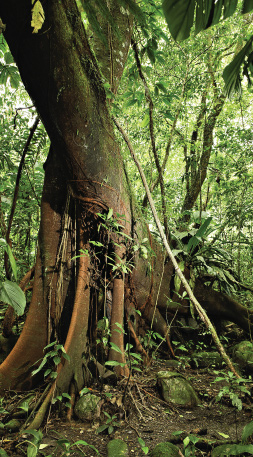
Brazil, home to one-third of the world’s rain forests, has established extensive reserves to prevent agriculture from encroaching. Deforestation has dropped in recent years. © Dirk Ercken / Shutterstock.com.
Previously, ranchers and farmers looking to expand their holdings would move into the forest illegally, occupy the land and eventually manage to legalize their claim (and often sell it off). But from 2003 until 2009, state and federal governments in Brazil created more than 270,000 square miles of new reserves near agricultural frontiers—an area larger than France. By designating new protected areas at the edges of farmland — rather than deep in the forest — the government all but abolished the allure of encroachment.
For a rancher, it’s not worth the investment to start cutting down the forest, says Steve Schwartzman, director of tropical forest policy at the Environmental Defense Fund, “because your likelihood of ever getting title to the land has gone way down.”
Daniel Nepstad, executive director of IPAM, the Amazon Environmental Research Institute, agrees. The expansion of protected areas, he says, “knocked the wind out of the land speculation market, which is a very important driving force behind deforestation.”
The Brazilian government also began calling out communities with the highest deforestation rates, cutting them off from government credit until they reformed. And it stepped up enforcement of land use laws, jailing hundreds of people for illegal logging and confiscating their machinery and timber.
Government actions alone don’t account for all of the slowdown in forest destruction. A drop in commodity prices — for both soy and beef — during the mid-2000s helped. And pressure from environmental groups, particularly Greenpeace, created a market rejection of deforestation in the form of an international backlash against Amazon soy and beef. Consumers “sent a message to farmers, saying, ‘If you’re clearing forests, we may not want your product,’” Nepstad says.
Today, however, the story is changing. A long and convoluted battle to change the country’s forest code — propelled by strong beef and soy lobbies — has put the future fate of Brazil’s forests at risk. The law, which contains hundreds of complicated amendments, may ultimately bog the country down in unclear and unenforceable rules that undermine the country’s decade of rain forest progress.
4: City of Vancouver
Challenge: Unsustainable Urban Expansion
Opportunity: Comprehensive Planning
More than half the world’s population currently lives in cities; by the middle of this century, that figure could hit 75 percent. Cities are responsible for two-thirds of human energy use and 70 percent of our greenhouse gas emissions, consume vast quantities of water, and produce enormous amounts of waste — all on just 2 percent of the world’s surface area.
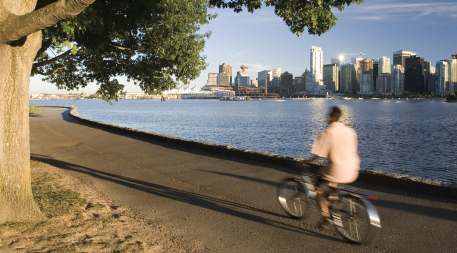
Extensive bikeways and a bike-share program are among the initiatives helping Vancouver move toward its goal of reducing greenhouse gas emissions 80 percent by 2050. ©Steve Rosset / Shutterstock.com.
How we design, build and live in our cities will have an outsized impact on the planet’s future. But many cities appear blind to this, lumbering forward on outdated building codes, leaking infrastructure and archaic, car-centered layouts.
And then there’s Vancouver. Through its Greenest City 2020 initiative, the Canadian metropolis has developed a 10-point plan to tackle everything from jobs and investment to buildings, transportation, waste and even food — all to emerge as the world’s most sustainable city.
A decade ago Vancouver vowed to meet Kyoto Protocol greenhouse gas emission standards citywide, and to exceed them by 20 percent within the government. Later, city leaders decided to reduce emissions 80 percent by 2050. And then they asked a radical question: “If we want to be the greenest city in the world, what do we need to do?” recalls David Cadman, a former Vancouver city council member who helped conceive the green blueprint and is now president of ICLEI Local Governments for Sustainability.
Borrowing ideas and technology from cities the world over, Vancouver began designing itself a smart future. Cadman proposed heating the Vancouver Olympic Village by tapping waste heat emitted from sewage pipes, and at first the city’s Today, residents make 40 percent of their trips in the city on foot, bike or public transportation.engineer balked. “I said, ‘Here’s the business card of an engineer in Switzerland, where they’ve been doing this for years,’” Cadman recalls. “So he called the guy.” The technology, which involves wrapping sewage pipe with a coil that collects the heat, debuted at the Olympics and now supplies 70 percent of the annual energy demand in Southeast False Creek, the neighborhood that encompasses the village. The program, known as a Neighborhood Energy Utility, has already lowered local greenhouse emissions from buildings by 74 percent (surpassing expectations of a 62 percent average annual reduction).
Elsewhere in the city, sustainable development is taking shape. Vancouver updated its mass transit to accommodate bicycles and built urban bike lanes that are physically separate from the streets. Today, residents make 40 percent of their trips in the city on foot, bike or public transportation (the goal is two-thirds of all trips by 2040). To help conserve water, the city now requires water meters on all new residential water services. And Vancouver has adopted the greenest building code in North America.
Every city is unique, of course, and not everything that works in Vancouver makes sense elsewhere. As a city already lauded for its quality of life, Vancouver could afford to set strict policies for developers. But the central ideas behind Greenest City are replicable in a broad sense: The way forward is a combination of creativity, smart policy and will. Vancouver’s efforts show that cities can thrive (the greater region of 2.3 million people is growing at 5 percent per year) while using fewer, not more, resources.
5: Bridges & Bicycles in India
Challenge: Population Growth
Opportunity: Improving education for girls
As world population careens toward 9 billion, all the planet’s systems will be strained. Lowering fertility rates is a complex endeavor, and no one path leads directly there. Poverty, access to contraception, education, job prospects, cultural mores — all of these influence family size. So addressing any of them, or a combination, can help. Solutions abound, at least on a relatively small scale, such as conservation programs that include family planning components.

Organizations such as the Foundation to Educate Girls Globally work with communities to identify and overcome barriers to girls’ education – some as basic as a lack of appropriate restrooms. Photo by Kim Seidl.
But the most promising opportunities may lie in promoting girls’ education. Study after study throughout the years has found the same thing: Across every culture, women with higher levels of education have, on average, fewer children. (Girls’ education is also correlated with higher individual and national income levels.) One recent analysis by the International Institute for Population Sciences in Mumbai, India, found that the relationship between education and fertility is mutual. Increased education is followed by decreased fertility — but women who have fewer children are also more likely to receive more education.
India is home to several innovative efforts. In Uttar Pradesh and Orissa, two states with massive gaps in gender inequality, CARE India runs “bridge” schools, residential programs that give girls who have had little or no schooling a chance to catch up. In one district where the literacy rate for girls was near zero, the non-governmental organization started its first Udaan (which means “flight”) 12 years ago. The school took in 100 students for 11 months in a round-the-clock program that not only taught them basic elementary school coursework but also focused on life skills — everything from leadership to cycling.
A recent “right to education” law makes education a fundamental right for children age 6 to 14, who are now entitled to free schooling.Gradually but steadily, the age at which the girls married increased, says Suman Sachdeva, technical director for education at CARE India, “so you now rarely see these girls get married before 18.”
CARE currently operates four Udaan schools in India, and the concept is spreading to other NGOs and even the government. A recent “right to education” law makes education a fundamental right for children age 6 to 14, who are now entitled to free schooling.
But what happens to those kids — many of them female — who are suddenly eligible for school but are now years behind? Sachdeva hopes the bridge school idea will help solve the problem and ensure that more girls can pursue an education.
Elsewhere in India, in 2007 the chief minister of Bihar state began giving schoolgirls vouchers to buy bicycles. Preliminary research shows the program has significantly increased the number of girls staying in school.
6: Tree Regeneration in Niger
Challenge: Unsustainable agriculture
Opportunity: Regenerating native trees
Farming in Africa’s drylands was tough enough before climate change and skyrocketing populations piled on extra problems. Today, smallholder farmers across Africa, but particularly in the Sahel, face pressure to feed their families on land with depleted soils, erratic rainfall and encroaching sand. In years to come, these farmers will need to produce more food on existing land, even as weather conditions grow more precarious.
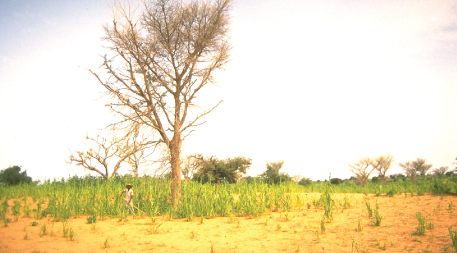
In Niger, trees like this acacia not only provide favorable growing conditions for crops, they also produce leaves and pods that can be used for fodder. Photo by Joost Brouwer.
Chris Reij has spent more than three decades working on sustainable agriculture in Africa, and his years of experience point to a solution that’s so low-tech and inexpensive it’s been overlooked by large aid agencies. Reij, sustainable land management specialist at the Centre for International Cooperation, oversees an effort called Africa Re-greening Initiatives. Re-greening means allowing native trees to grow back on farmland, and then tending, pruning and managing them for maximum return.
Trees provide an almost unbelievable number of benefits: They block wind, lower microclimate temperatures, reduce evaporation, fix nitrogen, provide livestock fodder and increase organic nutrients in the soil. They also generate edible fruits and leaves and produce firewood. Twenty years ago, says Reij, women in parts of Niger spent two-and-a-half hours each day collecting firewood; now they spend half an hour.
“It’s not the silver bullet, but it is at least a big piece of shrapnel,” Reij says.
Agroforestry isn’t new; African farmers grew crops alongside trees for centuries. But a severe drought in the 1970s forced farmers in Niger to cultivate extra land to offset declining crop yields. To expand they cut down trees, which only made things worse.
Starting in the 1980s, though — spurred on by a missionary — some farmers began encouraging trees to regrow from seeds stored in the soil. Reij’s initiative helps spread the message and the knowledge from village to village. Today he estimates that 5 million hectares in Niger have been re-greened. The effort has also spread to Mali, Burkina Faso, Ethiopia and elsewhere across the continent.
Low-tech, low-cost solutions can spur other changes in the ongoing search for solutions to Earth’s greatest environmental challenges.Although Niger, which was hard hit by drought and pests last year, has an overall deficit of cereal crops (up to 600,000 tons), one study found that in a district with a high incidence of on-farm trees, there was a cereal surplus of 14,000 tons.
There is no one solution to the problem of sustainable food production across the vast and varied continent of Africa. (The Polish journalist Ryszard Kapuscinski once wrote, “Only with the greatest simplification, for the sake of convenience, can we say ‘Africa.’”) But Reij’s farmer-managed re-greening does suggest some broad lessons: “Barefoot” science can be as important as the latest science. People are most likely to stick with an innovation if it yields rapid results. And low-tech, low-cost solutions can spur other changes in the ongoing search for solutions to Earth’s greatest environmental challenges.
7: Water Funds in Latin America
Challenge: Freshwater depletion/deterioration
Opportunity: Payments for ecosystem service
We may live on the blue planet, but 97 percent of that liquid is of the salted variety. And of the planet’s freshwater, just 1 percent is “readily accessible for direct human uses,” according to the Stockholm International Water Institute. Clean water is an increasingly scarce commodity, particularly in the developing world — where 90 percent of the additional 3 billion people who will inhabit the Earth by midcentury will live.
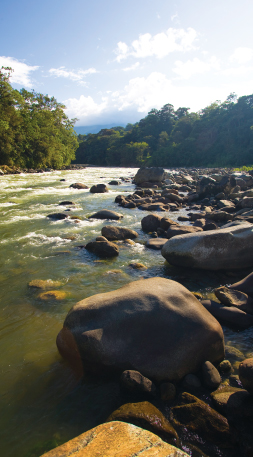
Among the best ways to ensure abundant supplies of fresh, clean water for human use is to protect ecosystems upstream. Photo by Jason Houston.
Water scarcity has many causes, from drought to inefficient infrastructure to poor (or no) sanitation to politics. Often the root of the problem is ecological: destruction of forests that help preserve clean water at its source, or farming practices that wash toxins into rivers and streams.
“I’ve seen places where cows are walking down steep sandy banks, causing local landslides,” says Heather Tallis, lead scientist at the Stanford University–based Natural Capital Project. “So just keeping cows out of the river can make a difference.”
One way to keep cows out of rivers — and to protect the ecosystems that protect freshwater supplies — is to value clean water as a resource and pay to safeguard its source. New York City did this when it bought and conserved land in the Catskills, where its drinking water originates. But buying up land isn’t the only option: Water users can pay upstream landowners to change how they use the land. For more than a decade, The Nature Conservancy has been attempting this by creating water funds across Latin America. Today, there are 35 funds either operating or in development from central Mexico to central Chile, and another 13 under consideration.
The idea is fairly simple: Water users — a hydroelectric power provider, an urban water utility, a brewery — pay into a fund and then spend that money to improve the watershed. Funds may pay farmers to change agricultural practices (reduce fertilizer use, fence cattle), pay guards to prevent ranchers from encroaching onto reserves or simply pay landowners to restore or preserve vegetation. Funds can focus on improving water supplies or water quality, or reducing risk from floods or landslides. In theory, the funds both protect vital water resources and also use the value of clean water to bankroll conservation.
The first fund, in Quito, Ecuador, was established 11 years ago. Little analysis has been done to monitor the effectiveness of the funds launched since then. Yet anecdotal evidence has been strong enough to entice a coalition of partners, including the World Bank, the Inter-American Development Bank and a Coca-Cola bottler, to join forces with TNC in the Latin America Water Funds Partnership, which will standardize the funds and intro-duce scientific monitoring. The idea is also spreading beyond the Americas: Kenya and Mongolia may be next in line.
![]()
This feature originally appeared in the Fall 2012 issue of Momentum, Ensia’s predecessor.
Ensia shares solutions-focused stories free of charge through our online magazine and partner media. That means audiences around the world have ready access to stories that can — and do — help them shape a better future. If you value our work, please show your support today.
Yes, I'll support Ensia!